Honey bees are exceptional engineers able to perform architectural feats unequaled by any other insects in their class. They build nests and hives that can hold tens of thousands of bees in relatively small spaces.
Bee colonies can house themselves in natural or artificial cavities or tree trunks called nests. Artificial or man-made structures housing bee colonies are called hives.
For the sake of simplicity in this article, we will refer to beehives as representing the natural or artificial housing for bee colonies.
What Exactly is a Beehive?
Bees are great engineers, the internal structure of the hive is made of wax combs that have perfect hexagonal prismatic wax combs at a rate of 25 cells per square inch. The cells are for storage of honey and pollen as well as brood-rearing and production. Wild beehives can be found in hollows of trees, cliffs, or voids in building structures like ceilings.
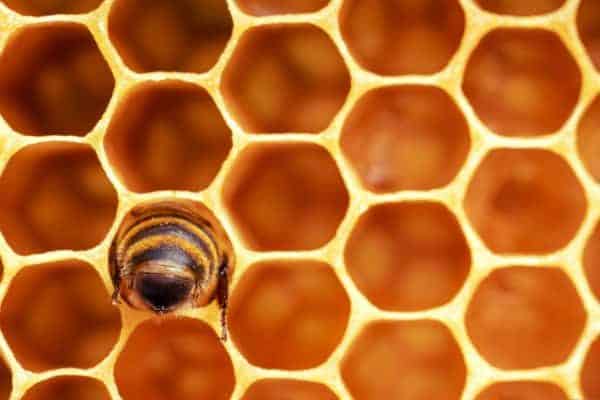
Modern beekeepers keep honey bees in timber or plastic hives that contain frames or bars that provide the structure for the bees to make their combs.
Let’s now take a closer look at some aspects of the beehive in relation to how it is made and the functions it has performed over time in both modern and ancient beekeeping.
How Do Bees Make Hives?
Worker honey bees construct the hives with wax and propolis. They use beeswax to make the six-sided hexagonal tubes that form cells in the combs of the hive. The shape allows for optimum storage capacity for holding honey and the design utilizes wax and space in the most efficient manner possible.
The geometric perfection of the combs aligns each cell right to the next with ingenious mathematical precision. This makes use of wax extremely efficient with no wastage.
The bees use propolis (a resin-like substance collected by worker bees from plants) to fill gaps and crevices in the hive. It is also used at the entrance of their hives to trap harmful microbes from bees’ legs as they return to the hive from foraging trips.
In case a predator or intruder strays into the hive, the bees will sting it to death and use propolis to embalm it if it proves difficult for the bees to remove. Embalming prevents decomposition, thus removing a potential health risk to the hive.
At the entrance to the hive, you can observe the conspicuous way bees use propolis to construct a kind of barrier or barricade with just enough spaces and gaps for them to get in and out. But larger intruders or pests can’t get in easily.
Before they settle on a location to build a hive, bees send out scouts to look for the perfect site. This could be in a beehive in the ceiling or on a tree trunk that offers protection from nature’s elements.
Once they settle on a location, they begin the construction of the combs from the top down. They use propolis to attach the comb onto the frames in a hive or tree trunks. The uppermost sections of the comb contain honey.
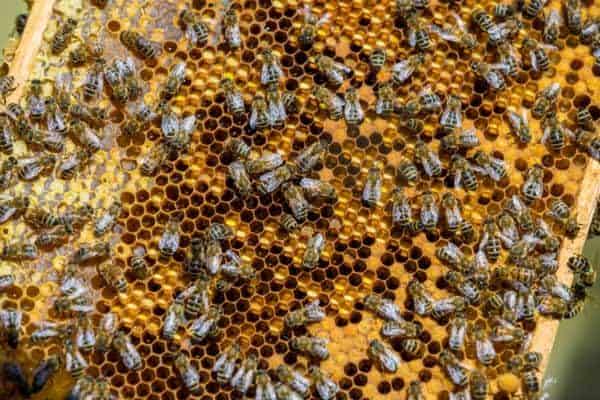
Pollen is stored in the rows below honey, worker brood cells below that, and then drone bees cells. The queen bee cells (supersedure cells) are at the bottom of the comb and are easy to identify because they are bigger and usually protrude downwards.
To help protect the colony from harmful germs and intruders, propolis becomes an important part of the bee’s building materials which they use at various stages of construction.
How Do Bees Create The Wax Combs In Their Hives?
Honey Worker bees have eight special glands located in their abdomens that produce wax that turns into tiny wax flakes.
The wax glands become active when worker bees, at 10 days to 20 days old, gorge on honey that stimulates the glands to begin producing wax. Other worker bees remove the tiny wax flakes and chew them to soften them enough to shape and use in the construction of comb in the hives.
The bees meticulously position the fresh wax to form perfect hexagonal shaped cells, each cell having sufficient depth for honey storage and/or brood rearing.
Worker bees then polish the cells and await inspection of dimensions and cleanliness by the queen bee. The queen will only lay eggs in comb cells that are perfect.
We have another article that goes into “How bees make wax” if you are interested.
What is the function of the beeswax comb in a hive?
The combs in a beehive have several functions. The combs in the hive, as previously mentioned, consist of many individual cells. These cells are used to store pollen, nectar, honey, eggs, water, and brood in various stages of development.
The combs in the beehive can support 30 times their own weight, mainly because of their hexagonal shape that allows for optimum utilization of all available space.
The combs also have the ability to trap impurities from brood production, which helps in maintaining healthy hygiene levels in the hive. The wax combs can be reused multiple times by the bees. As they age, the combs tend to darken in color due to brood impurities and pollen.
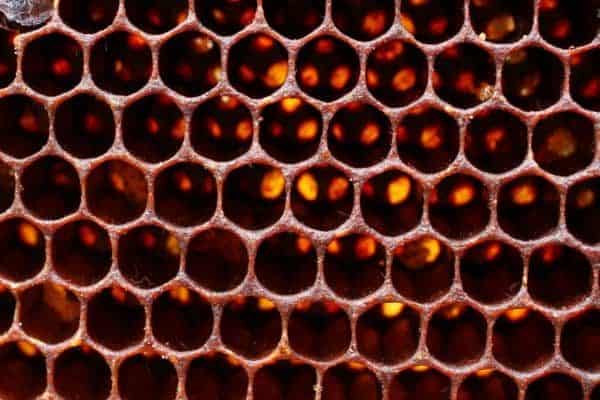
One of the most widespread agricultural activities that are practiced the world over is beekeeping and descended traditionally through generations.
What Did The First Beekeepers Make Hives Out Of?
The first beekeepers made traditional beehives out of mud, unfired clay cylinders shaped like jars, clay tiles or jars, skeps, and bee gums. The bees created their own honeycombs since no internal structures were provided.
Harvest generally destroyed the hives because the comb cannot be moved as it is often cross-attached. This is different from the modern movable-frame hives and is sometimes called a fixed-frame hive. Now let’s delve briefly into the four different types of traditional hives.
Mud Hives
Mud hives are cylinders made from a mixture of unbaked mud, straw, and dung. These types of hives are of a simple structure and are still used in Egypt and Siberia.
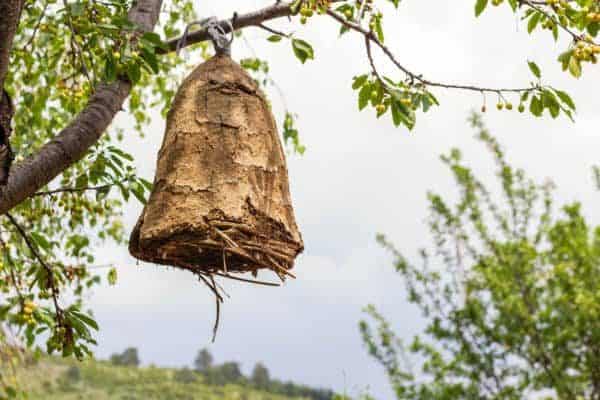
Clay Hives
Customarily, clay tiles were homes of kept bees in ancient Egypt, the Middle East, and to some extent Greece, Malta, and Italy. They were often stacked in rows to provide shade for those at least not on top of the pile. Harvesting was done using the traditional method of driving the bees by smoke to one end and robbing the honey from the other end.
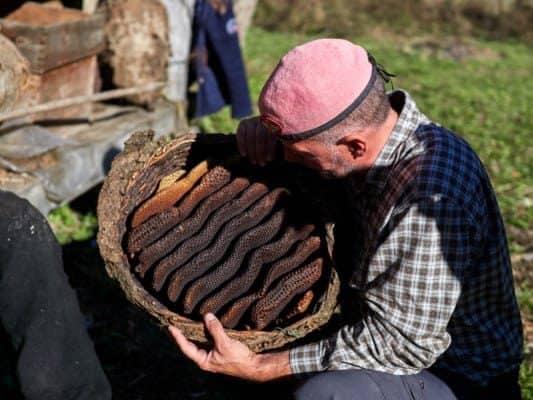
Skeps
It’s believed that skeps have first been used in Ireland, to house bees for some 2000 years. They were initially made from wicker plastered with mud and dung. Skeps are basically baskets placed open-end down and in its simplest form, there is a single entrance at the bottom.
After the Middle Ages, almost all were made of straw and there is no internal structure provided for the bees.
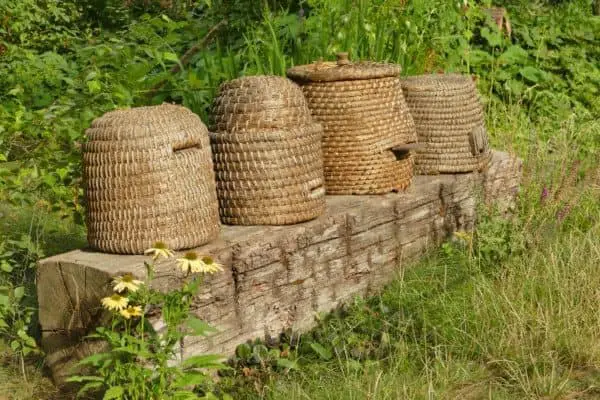
And so the colony must produce its own honeycomb which is attached to the inside of the skep. Honey removal is difficult with skeps and often results in the destruction of the entire colony.
Inspecting the comb for diseases, parasites, and pests is not possible with skeps and most US states prohibited the use of skeps as of 1998.
Bee Gums
These were sections of hollow trees that often were from the gum tree (hence the name “gums”). Bee gums were common in the eastern United States, especially in the South East. They were set upright in “bee yards” or apiaries.
Sticks or crossed sticks were sometimes placed under a board to give an attachment to the honeycomb. Often at harvesting time, the harvester would kill the bees before even opening their nest by inserting a metal container of burning sulfur in the gum.
In central Europe, artificially hollowed tree trunks, as well as natural tree hollows, were widely used by beekeepers. In Poland, a hollowed tree trunk beehive was called a “barc”. Here harvest of honey did not destroy the colony because only a protective piece of wood (cover) was removed from the open end and smoke was used to calm down the bees.
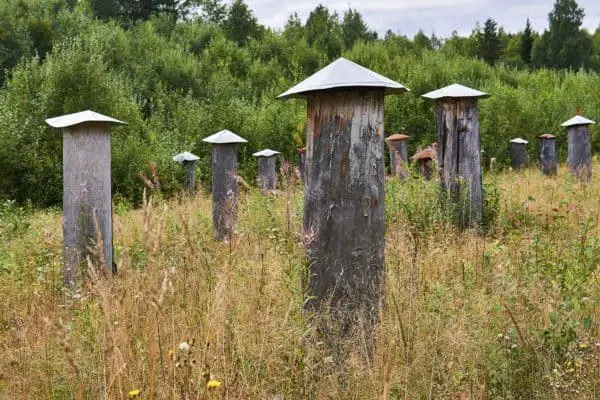
In East African beekeeping communities, artificially hollowed tree trunks were commonly used in addition to natural occurring tree hollows. These communities, some of who are traditionally forest dwellers such as the Ogiek of the Mau forest in Kenya, are skillful beekeepers and harvesters of wild honey.
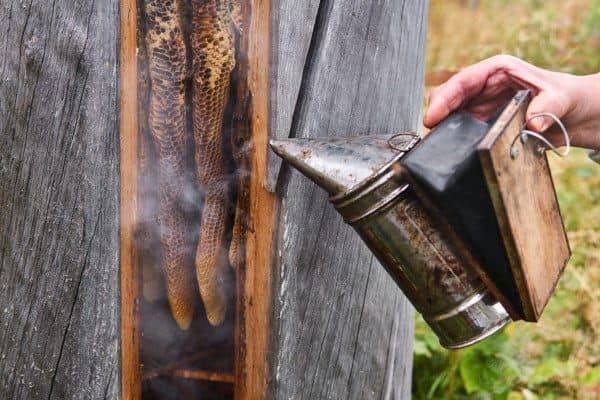
Harvesting from log beehives did not necessarily mean destroying the colony since smoking was the preferred method of pacifying the bees. Typically, the hives which can still be found in some communities today vary in size and are hollowed out artificially. They are usually placed on high tree trunks for safety.
How Long Have Beekeepers Been Keeping Bees?
Archeologists recently discovered evidence of what appears to be the oldest signs of beekeeping in the world in Jordan valley in Israel. This site is known as Tel Rehov and is located in the northern part of Israel.
The exceptionally well-preserved remains found at the Tel Rehov site date back to the Iron Age, about 3000 years ago. They provide unequivocal solid evidence as to the most ancient beehives ever found.
The unfired clay cylinders discovered at this site contained the remains of honey bee drones, workers, and pupae larvae. Amazingly, an estimated 100 to 200 hives were included in this apiary.
The design of each jar was such that it had a small hole on one side for the bees to enter and exit, and a lid on the opposite side for the beekeepers to access and harvest the honeycomb.
Another study by the University of Bristol found evidence that shows early farmers exploited beehive products at least 8500 years ago.
New research published in Nature today depicts Pharaonic Egyptian murals showing early scenes of beekeeping and previous evidence from prehistoric rock art shows honey hunters. This research was able to detect beeswax evidence in cooking pots from archeological sites in Turkey dating to the seventh millennium BC. This is the oldest evidence yet for the use of bee products by farmers 8500 years ago.
Pinning down when beekeeping actually began is somewhat difficult because, until recent discoveries in Israel, evidence was restricted to texts and wall paintings and of course oral history.
The earliest documented evidence dates back to the Bronze Age Mediterranean where most Bronze Age States including Egypt, Sumer, Assyria, Babylonia, and the Hittite kingdom all had apiaries and practiced beekeeping.
On the walls of the Sun Temple of Egyptian pharaoh Nyusserre Ini, depictions of beehives, honeypots, and beekeepers using smoke to calm bees, is an indication that beekeeping was a well-developed and organized industry during the Bronze Age. King Nyusserre was the sixth king of the Fifth Dynasty (c2465-c 2325 bc).
Do Bees Make Their Hives Out In The Open?
There are more than 20,000 species of bees worldwide, 70% of which do not live in hives. The better half of the species live outside of hives, with many living in underground nests.
These are generally known as Ground Nesting Bees and consist of many native bees. Among them are species such as Digger bees, sweat bees, mining bees, orchard bees, bumblebees and mason bees. Except for the bumblebees which live in colonies, the rest are solitary bees.
On the other hand, honeybees live in colonies and are eusocial insects. They can be found out in the open in natural occurring tree hollows, on cliffs, on high tree trunks or other suitable structures.
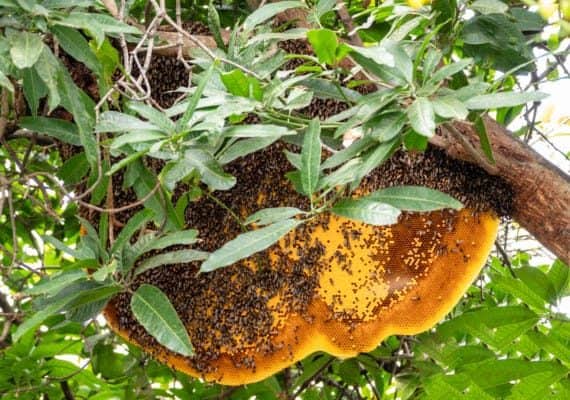
They can build a nest that is not enclosed in a man-made hive and carry on with the business of building combs, raising brood, and storing honey in comb cells.
This is especially common in the tropics and equatorial regions where the climate is not widely extreme. These bees can build impressively huge honeycombs since they aren’t constrained by a box hive.
Let’s look at some species and their nesting traits and peculiarities.
Himalayan Bees
Dwarf and giant honeybees practice open-air nesting which makes it difficult to keep them in man-made hives. A good example of a giant bee is the Himalayan bee. It is the biggest bee in the world. These giant bees live on high cliffs at the foot of Nepal’s mountains.
They make giant honeycombs and fill them with honey that has hallucinogenic properties, also commonly known as mad honey. The honey is harvested twice a year by the Kulung people under extremely difficult and risky conditions.
The hallucinogenic effects of Nepalese honey come from the rhododendron pollen which contains a substance called grayanotoxin. The demand for this honey is huge and attracts a steep price.
Ground Nesting Bees
As the name suggests, ground bees build their nests in the ground. We will briefly have a glance at a few of these bee species. Their nests are easy to identify above ground because of the conical piles of dirt with a large hole in the middle that serves as the entrance to the barrows.
Unlike social bees and wasps, these are solitary species and are not aggressive though females do have a sting. Every female individual builds her own nest. Being gregarious nesters -meaning many females build their nests next to each other, these solitary bees may build hundreds or thousands of nests next to each other. Ground bees are greatly beneficial as pollinators.
Bumblebees
Bumblebees are eusocial insects like honeybees and they live in small colonies of about 50 insects to 400. They commonly nest in the ground, often in abandoned rodent burrows or small cavities.
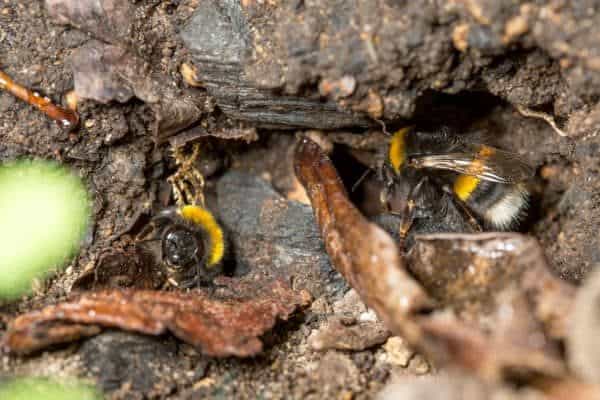
The queen bee spends the long cold winter hidden away, unlike the honeybees which overwinter clustering together to generate and conserve heat. In spring after the queen emerges and identifies a suitable nest site, she builds a ball of moss, hair, or grass with a single entrance.
Once the nest is ready, she prepares for her offspring by building a wax honeypot and provisions it with nectar and pollen. Next, she forms pollen into a mound on the floor of her nest then lays eggs in the pollen and coats it with wax from her body. She incubates her eggs by sitting on the pollen mound and raising her body temperature to between 98°Farenheit and 102°F.
Carpenter Bees
Carpenter bees resemble large bumblebees and are commonly found buzzing around dwellings and other structures such as decks, porches, outdoor wood furniture, and other unpainted /untreated wooden areas.
Carpenter bees derive their name from their habit and ability to drill perfectly round holes in exposed wood to make nests. The bees burrow 1/2 diameter holes using their short broad mandibles.
The female carpenter bee will drill a 2-inch hole against the wood grain, then she makes a 90-degree turn and drills a parallel tunnel of 4 to 6 inches along the grain.
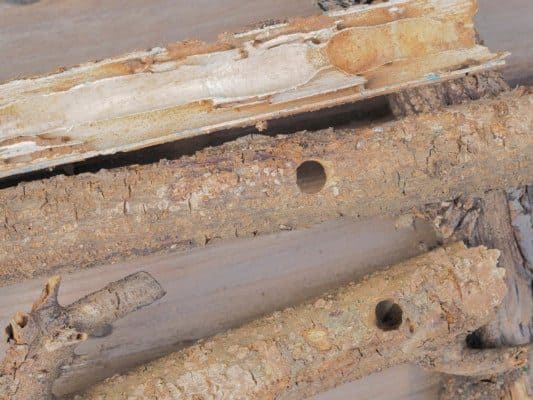
She can drill to almost four feet to form a gallery in which she will drill and excavate small chambers a few inches deep. These chambers become egg holders. In each chamber, she will bring in a mass of pollen and regurgitated nectar formed into a ball on which she will lay an egg.
Next, she seals off the egg cells by mixing sawdust and saliva, making partition walls that closely resemble particleboard. Then working back to front, the bee leaves each cell with a pollen ball and a single egg.
Mason Bees
Mason bees habitually use mud or other “masonry” materials in the construction of their nests, hence the name. They build their nests in naturally occurring gaps such as between cracks in stones or similar small dark cavities. Some species prefer using hollow stems or holes in wood made by other wood-boring insects.
Mason bees use mud to make partitions and to seal the entrance. They are solitary like most native bees. However, they are gregarious and happily build their nests next to each other. They also readily build nests in hollow tubes provided by the orchard growers for this purpose.
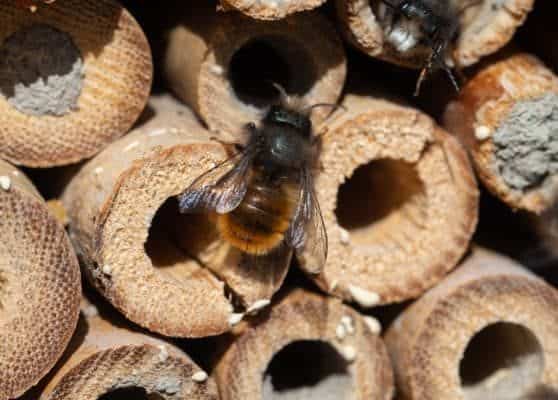
Mason bees are very efficient pollinators of fruit trees to the extent that they are also called orchard bees. By placing hand-made or store-bought bee houses or bee blocks in their yards, gardeners and commercial fruit farmers take advantage of mason bees’ prolific prowess in the pollination of their trees and plants.
In spring, female mason bees collect pollen and nectar and bring it into their nests. They knead it into a ball, mixing it with their own saliva. Once they have ample food stores, they lay an egg on top of this mass and seal off the chamber or cell. They then seal off the cell using a little mud wall to separate the cell from the subsequent one. They repeat this process until there are five to eight cells each with food and one egg. Then they seal the entrance hole with a thicker mud wall.
What Are The Advantages Of Modern Beehive Designs?
Modern beehives are designed to host honey bees in a versatile and efficient configuration allowing beekeepers to manage them with ease. Unlike the traditional beehives we have covered in this post, harvesting honey can be done without destroying the colony.
Inspection of bees for diseases and pests is much easier and can be done as often as needed without stressing the bees. Controlling the colony is also a lot easier, especially with the Langstroth hive.
The Langstroth hive can be manipulated to hold more or less bees by the use of super boxes that can be stacked on top of one another. They produce more honey if well managed and remain free of disease. They are also quite durable and easy to repair.
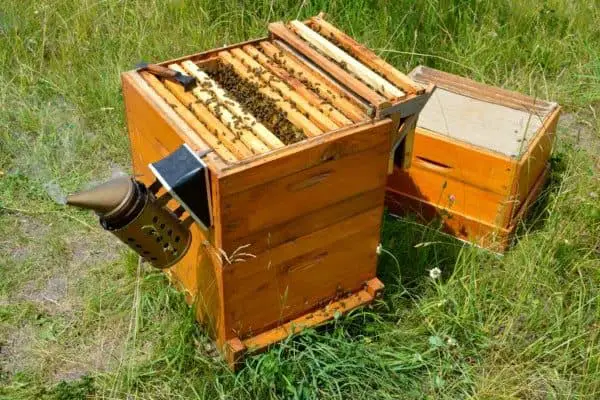
Can the Wax Combs be Reused and Do They Wear Out?
Bees tend to lead a very sustainable lifestyle and reuse combs again and again over many years. The wax combs are super resilient and don’t wear out with constant and repeated use. Unless they are attacked by pests such as hive beetles, they can be used for many years.
New combs are usually whitish in color, as they age and are used for brood rearing and honey storage, they change color to dark brown and eventually black over time. The combs also help to trap impurities that might find their way into the hive.
The Wrap Up
The functions of a beehive basically remain the same, whether the bees are in an open nest out in the wild or in an apiary. Beekeeping has come a long way since biblical times and the ancient Egyptian Bronze Age. Having evolved over many centuries, it remains as fascinating today as it must have been during the Pharaonic ages.
References
https://en.wikipedia.org/wiki/Grayanotoxin
https://www.sciencedirect.com/topics/neuroscience/grayanotoxin
https://en.wikipedia.org/wiki/Langstroth_hive
https://www.researchgate.net/publication/291853946_It_is_the_land_of_honey_Beekeeping_at_Tel_Rehov
https://www.bristol.ac.uk/news/2015/november/honeybees-and-neolithic-farmers.html
